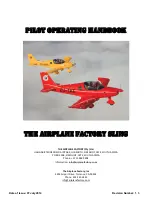
Aircraft Operating Instructions (AOI)
Type:
CT
Series:
CTLS
LSA
Page: 5-11
AU 010 11000
Revision No. 4
Date: 29 Apr 2008
5.7. Gliding
characteristics
The following chart shows the distances the aircraft can glide, dependent upon
altitude, assuming smooth air, no wind and no vertical air currents.
5.
000 f
t
10.
000 f
t
5 NM 10 NM 15 NM
Flaps -6° / 140 km/h
K15° / 100 km/h
5.
000 f
t
10.
000 f
t
5 NM 10 NM 15 NM
Flaps -6° / 140 km/h
K15° / 100 km/h
Warning:
Intensive thermal activity can prolong these distances. Turbulence,
however, usually leads to a reduction in gliding distance. One should
never expect favorable conditions when estimating a possible gliding
distance!
Glide angle of the CTLS can be assumed in practice to be 8.5 to 1. With flaps
extended this ratio gets worse. One effect of moderately set flaps is to reduce the
minimum sink, but the speed at which the minimum sink is observed reduces faster.
This results in a reduced possible gliding distance. Speeds for best glide at flight
mass and negative flaps can be assumed as follows:
600 kg (1320 lbs)
140 km/h (78 kts)
500 kg (1100 lbs)
124 km/h (69 kts)
400 kg (880 lbs)
115 km/h (64 kts)








































